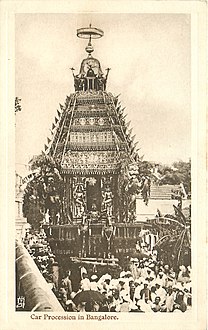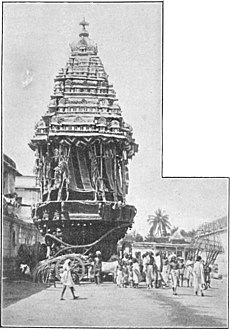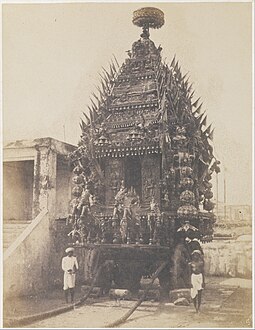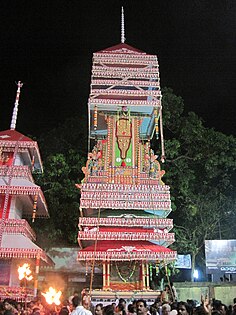Temple car
This article needs additional citations for verification. (January 2017) |

Temple cars[1][2] or Temple chariots are used to carry representations of Hindu gods around the streets of the temple on festival days. These chariots are generally manually pulled by the devotees of the deity.
As of 2004, Tamil Nadu had 515 wooden carts, 79 of which needed repairs.[3] Annamalaiyar Temple, Tiruvannamalai, Chidambaram Natarajar Temple are among the temples that possess these huge wooden chariots for regular processions.
The Natarajar Temple celebrates the chariot festival twice a year; once in the summer (Aani Thirumanjanam, which takes place between June and July) and another in winter (Marghazhi Thiruvaadhirai, which takes place between December and January). Lord Krishna of Udupi has five temple cars, namely Brahma ratha (the largest), Madya ratha (medium), kinyo (small), and the silver and gold rathas.
The size of the largest temple cars inspired the Anglo-Indian term Juggernaut (from Jagannath), signifying a tremendous, virtually unstoppable force or phenomenon.
History[edit]


Temple cars are used during festivals called Ratha Yatra, a procession in a chariot accompanied by the public. It typically refers to a procession (journey) of deities, people dressed like deities, or simply religious saints and political leaders.[4] The term appears in medieval texts of India such as the Puranas, which mention the Ratha Yatra of Surya (Sun god), of Devi (Mother goddess), and of Vishnu. These chariot journeys have elaborate celebrations where the individuals or the deities come out of a temple accompanied by the public journeying with them through the Ksetra (region, streets) to another temple or to the river or the sea. Sometimes the festivities include returning to the sacrosanctum of the temple.[4][5]
Traveler Fa-Hien who visited India during 400 CE notes the way temple car festivals were celebrated in India.
The cities and towns of this country [Magadha] are the greatest of all in the Middle Kingdom [Mathura through Deccan]. The inhabitants are rich and prosperous, and vie with one another in the practice of benevolence and righteousness. Every year on the eighth day of the second month they celebrate a procession of images. They make a four-wheeled car, and on it erect a structure of four storeys by means of bamboos tied together. This is supported by a king-post, with poles and lances slanting from it, and is rather more than twenty cubits high, having the shape of a tope. White and silk-like cloth of hair is wrapped all round it, which is then painted in various colours. They make figures of devas, with gold, silver, and lapis lazuli grandly blended and having silken streamers and canopies hung out over them. On the four sides are niches, with a Buddha seated in each, and a Bodhisattva standing in attendance on him. There may be twenty cars, all grand and imposing, but each one different from the others. On the day mentioned, the monks and laity within the borders all come together; they have singers and skillful musicians; they pay their devotion with flowers and incense. The Brahmans come and invite the Buddhas to enter the city. These do so in order, and remain two nights in it. All through the night they keep lamps burning, have skillful music, and present offerings. This is the practice in all the other kingdoms as well. The Heads of the Vaisya families in them establish in the cities houses for dispensing charity and medicines. All the poor and destitute in the country, orphans, widowers, and childless men, maimed people and cripples, and all who are diseased, go to those houses, and are provided with every kind of help, and doctors examine their diseases. They get the food and medicines which their cases require, and are made to feel at ease; and when they are better, they go away of themselves.
— Faxian, c. 415 CE[6]
Early photographs and lithography of temple chariots[edit]
- Vintage Temple chariot procession pictures
-
Someshwara Temple chariot in 1918.
-
Chariot procession in Madurai in 1872.
-
Banashankari Temple (Badami) chariot in 1855.
-
Srirangam Temple chariot in the 1890s.
-
Juggernaut Car, Madras, 1850.
-
Three temple cars outside the Hanuman Dhoka, or Old Palace, Kathmandu - Oldfield collection (1850-1863)
-
The Car of Juggernaut, as depicted in the 1851 Illustrated London Reading Book
-
Tempel car in Bangalore, 1870
Largest temple chariot[edit]

The procession of the Asia's largest and greatest temple car of Thiruvarur Thiyagarajar Temple in Tamil Nadu features prominently in an ancient festival held in the town.[7] The annual chariot festival of the Thygarajaswamy temple is celebrated during April – May, corresponding to the Tamil month of Chitrai. The chariot is the largest of its kind in Asia and India weighing 300 tons with a height of 90 feet. The chariot comes around the four main streets surrounding the temple during the festival. The event is attended by lakhs of people from all over Tamil Nadu.[8]
The Aazhi Ther is the biggest temple chariot in Tamil Nadu. The 30-foot tall temple car, which originally weighed 220 tons, is raised to 96 feet with bamboo sticks and decorative clothes, taking its total weight to 350 tons. Mounted on the fully decorated temple car, the presiding deity – Lord Shiva – went around the four streets with the devotees pulling it using huge ropes. Two bulldozers were engaged to provide the required thrust so that devotees could move the chariot.[9]
Gallery[edit]
-
Taladhwaja, Darpadalana and Nandighosha in 2021 Ratha Jatra, Odisha, India.
-
Temple festival in Chidambaram, Tamil Nadu, India.
-
Tiruvarur temple car, the largest (chariot) temple car in the world, it weighing 300 tonnes (295 long tons; 331 short tons) with a height of 90 feet (27.43 m).
-
Type of temple car called Theru from the Chettikulangara Kumbha Bharani, Kerala
-
Type of temple car called Kuthira from the Chettikulangara Kumbha Bharani, Kerala
-
Bisket Jatra Chariot Bhaktapur, Nepal.
-
Picture of Tirunelveli Nellaiappar Temple Golden car.
-
Picture of Alwarkurichi People pulling Sivasailanathaswamy Temple car.
-
Temple cars in front of Jagananth temple, 2021
List of places with traditional Temple cars[edit]
India[edit]
Tamil Nadu[edit]
- Alwarkurichi, Tenkasi
- Aragalur
- Avinashi (Sri Avanashiappar Temple)
- Bhavani Kooduthoorai, Tamil Nadu (4 chariots)
- Coimbatore, Tamil Nadu (Koniamman Temple)
- Chidambaram, Tamil Nadu (Nataraja Temple)
- Dindigul (Abiramiyamman Kovil)
- Denkanikottai (Betarayaswamy Kovil)
- Erode (Chennimalai, Sivagiri, Sivanmalai)
- Gobichettipalayam (Sri Kondathukalaimman Temple, Sri Balamurugan Temple and others)
- Kadayanallur
- Kallal Town (Somasundareswarer Kovil)
- Kanchipuram (Varadharaja Perumal Temple, Ekambareswarar Temple and others)
- Karuvalur (Shri Mariamman Kovil)
- Karamadai (Ranganathaswamy temple)
- Kumbakonam (Sri Saarangapani Temple and others)
- Lalgudi (Saptharishishwarar Temple)
- Madurai (Sri Meenakshi Amman Temple and others)
- Mannargudi (Sri vidhya Rajagopalaswamy temple)
- Minjur (Sri Ekambaranatha temple)
- Mylapore, Chennai (Kapaleeshwarar Temple)
- North Authoor (Sri Somanathar Somasundari Temple)
- Palani
- Perur (Patteewarar Temple)
- Sakkottai, Karaikudi
- Sankarankovil (Sankara Narayanasamy Temple)
- Srivaikuntam (Sri Srivaikuntanathan Permual Temple – Fourth largest temple car in Tamil Nadu)
- Suchindram (Thanumalayan Temple)
- Srivilliputtur (Sri Andal Temple - Second largest temple car in Tamil Nadu)
- Salem (Elampillai, Aranagalur, Rasipuram)
- Sholinghur Sri Lakshmi Narasimha Swamy temple,Sholinghur.
- Srimushnam (Boovaraha Swami temple - Second largest temple car in Tamilnadu[citation needed])
- Tiruchendur (Sri Subramanya Swami temple)
- Thirupathiripuliyur, Cuddalore (Padaleeswarar temple)
- Thiruvanthipuram, Cuddalore District (Devanathaswamy temple)
- Tirunelveli (Sri Nellaiappar Temple – Third largest temple car in Tamil Nadu)
- Tiruchengode (Sri Arthanareeswarar Temple - Fourth largest temple car in Tamil Nadu)
- Tiruvannamalai (Annamalaiyar, unnamulai amman temple, 5 Chariots)
- Tirupattur (Aruilmigu Muthukumara Swamy Thirukkovil, God Shiva chariot)
- Thirthahalli
- Tiruvallur
- Tiruvidaimarudur (Mahalinga Swamy) Schariots
- Thungapuram (Ariyalur-Perambalur)
- Thiruvarur (Thiyagarajar Temple - First largest temple car in Asia)[citation needed]
- Thiruthangal (Perumal Kovil)
- Thirukoshtiyur (Sri Sowmiya Narayana Perumal Kovil)
- Vickramasingapuram (Sivanthiappar Kovil)
- Virudhunagar
- Vasudevanallur (Sri Cinthamani Nathar temple (arthanathiswarar temple)
Karnataka[edit]
- Bantwal
- Gokarna (Sri Mahabaleshwara Temple)
- Hampi (Immovable stone chariot built by Vijayanagara Kings)
- Karinjeshwara
- Kateel (Shri Durga Parameshwari Temple)
- Kollur, Udupi (Mookambika Temple)
- Mangalore (Shri Venkataraman temple)
- Nanjangud (Srikanteshwara Temple)
- Mulki (Shree Venkataramana Temple)
- Mulki (Shree Kalikamba Temple)
- Mulki (Shri Bappanadu Temple)
- Mysuru (Chamundeshwari Temple)
- Puttur, (Shri Maha Lingeshsara Temple)
- Suratkal
- Udupi
Odisha[edit]
Kerala[edit]
- Chettikulangara, (Chettikulangara Devi Temple)
- Cherai
- Palakkad, Kerala (Many temples in settlements of Palakkad)
Andhra Pradesh[edit]
Others[edit]
- Manali New Town (Aiyya Temple)
- Yanam
Malaysia[edit]
- George Town (Nattukkottai Chettiar Temple)
- Kuala lumpur (Seri Maha Mariamman Temple Devasthanam)
- Teluk Intan (Nagarathaar Sri Thendayuthapani)
Sri Lanka[edit]
Germany[edit]
List of places with golden Temple cars[edit]
Andhra Pradesh[edit]
- Lord Shiva temple
- Narasimhaswami temple and tirumala Sri vari ratham
Karnataka[edit]
- Gokarna (Shri Mahabaleshwar temple)
- Kateel (Shri Durga Parameshwari temple)
- Kollur (Mookambika Temple)
- Konchady, Mangalore (Mahalasa Narayani Temple)
- Udupi (Sri Krishna matha)
Puducherry[edit]
- Sri Arulmigu Manakula Vinayagar, Pondicherry, Puducherry
Tamil Nadu[edit]
- Arulmigu Maruntheeswar, Thiruvanmiyur, Chennai
- Arulmigu Devi Karumariamman, Thiruverkadu, Chennai
- Arulmigu Vadapalani Andavar, Vadapalani, Chennai
- Arulmigu Kamatchiamman, Mangadu, Chennai
- Arulmigu Kanthaswamy, Parktown, Chennai
- Arulmigu Mundakakanniamman, Mylapore, Chennai
- Arulmigu Kapaleeswarar, Mylapore, Chennai
- Maruthamalai, Coimbatore (Subramanya Swamy Temple)
- Coimbatore (Eachanari Vinayagar Temple)
- Coimbatore (Thandu Mariamman Temple)
- Arulmigu MeenakshiSundareswarar, Madurai
- Arulmigu Solaimalai Murugan, Pazhamudircholai, Alagarkovil Madurai
- Arulmigu Jambukeswarar, Thiruvanaikkaval, Trichy
- Arulmigu Nellaiappar Temple, Tirunelveli
- Arulmigu Ramanathaswamy, Rameswaram
- Arulmigu Subramaniaswamy, Thiruchendur
- Arulmigu Kamatchiamman, Kanchipuram
- Arulmigu Dandayuthapaniswamy, Palani
- Arulmigu Swaminathaswamy, Swamimalai
- Arulmigu Subramanyaswamy, Thiruttani
- Arulmigu Anjaneyaswamy, Namakkal
- Arulmigu Pachaimalai Murugan, Gobichettipalayam
- Arulmigu Pariyur Kondathu Kaliamman, Gobichettipalayam
- Arulmigu Mariamman, Bannari, Erode
- Arulmigu Velayuthaswamy, Thindalmalai, Erode
- Arulmigu Arthanareeswarar, Tiruchengode
- Arulmigu Subramaniyaswamy, Sivanmalai, Tirupur
- Arulmigu Kottaimariamman, Dindigul
- Arulmigu Arunachaleswarar, Thiruvannamalai
- Arulmigu Vaidhyanathaswamy, Vaitheeswaran Kovil
- Arulmigu Mahalinga Swamy Temple, Thiruvidaimarudur (SILVER CHARIOT)
- Arulmigu SankaraNarayanaswamy, Sankarankovil
- Nanguneri (Arulmigu Vanamamalai Perumal)
- Arulmigu Balamurugan, Raththinagiri
- Arulmigu Mariamman, Samayapuram
- Arulmigu Masaniamman, Anamalai
- Arulmigu Mathurakaliyamman, Siruvachur, Perambalur District
- Arulmigu Angalaparameshwari Amman, Melmalayanur, Villupuram District
- Arulmigu Natarajar Temple, Chidambaram, Cuddalore District - the chariot for Pichandavar on the eighth day of 10-day long festival
- Arulmigu Yoga Lakshmi Narasimar temple, Sholinghur, Ranipet district.
- Arulmigu Vijayapuri Amman temple, Vijayamangalam,Erode
See also[edit]
References[edit]
- ^ Rajarajan, R. K. K.; Rajukalidoss, Parthiban. "Nāyaka Chefs-d'oeuvre: Structure and Iconography of the Śrīvilliputtūr Tēr". Acta Orientalia.
- ^ Rajarajan, R. K. K. "Iconographic Programme in Temple Cars: A Case Study of Kūṭal Alakar tēr". East and West, Istituto Italiano per l'Africa e l'Oriente (IsIAO), Rome.
- ^ "Government of Tamil Nadu Welcomes You". tn.gov.in. Archived from the original on 19 December 2012.
- ^ a b Michaels; Cornelia Vogelsanger; Annette Wilke (1996). Wild Goddesses in India and Nepal: Proceedings of an International Symposium, Berne and Zurich, November 1994. P. Lang. pp. 270–285. ISBN 978-3-906756-04-2.
- ^ Mandai, Paresh Chandra (2012). "Rathajatra". In Islam, Sirajul; Jamal, Ahmed A. (eds.). Banglapedia: National Encyclopedia of Bangladesh (Second ed.). Asiatic Society of Bangladesh.[permanent dead link]
- ^ Fa-Hien (1875). "A Record of Buddhistic Kingdoms (Chapter XXVII: Pataliputra or Patna, In Magadha)". gutenberg.org. Translated (published 415).
 This article incorporates text from this source, which is in the public domain.
This article incorporates text from this source, which is in the public domain.
- ^ "Official Website of Arulmigu Thiyagaraja Swamy Temple,Tiruvarur - Festival". thiyagarajaswamytemple.tnhrce.in. Retrieved 10 March 2021.
- ^ "Festivals, Culture & Heritage | Tiruvarur District, Government of Tamil Nadu | India". Retrieved 9 March 2021.
- ^ Kumar, K. Sambath (16 June 2016). "Car festival held at Tiruvarur Thyagaraja Swamy Temple after a gap of six years". The Times of India. Retrieved 9 March 2021.


















